PARAMETRIC SYSTEM IDENTIFICATION APPLIED TO THE BOW SHOCK WAVE SHAPE
DOI:
https://doi.org/10.5380/reterm.v12i1.62029Keywords:
compressible fluid flow, shock wave, shape and position shockAbstract
In this paper it is addressed the prediction of form and location of detached shock waves ahead of two-dimensional and axially symmetric bodies at an zero angle of attack. As shown in Figs. 5 and 6, results show a very good agreement with experimental data. In this context an approximate method, based on a simplified form of the continuity relation, is developed to predict the location of detached shock waves ahead of two-dimensional and axially symmetric bodies. In order to reduce the problem to an equivalent onedimensional form, it is assumed that: (1) The form of the shock between its foremost point and its sonic point is adequately represented by a hyperbola asymptotic to tile free-stream Mach lines; and (2) the sonic line between the shock and the body is straight and inclined at a constant angle. Although the new methodology has some points of contact with earlier methodologies, the novelty here is that it is used Missile Datcom code as an aid to find out sonic point on body and also it is adopted Parametric System Identification (PSI) in the determination of bow shock shape which uses the Matlab® optimizer fmincon function and an active set strategy to minimize an error in a rms sense subject to simple constraint placed on the parameters by the user. The optimizer function calls a user written function which calculates the shape of the shock wave using the current parameters supplied by optimizer. Also for the shock distance L, the methodology presented here allows to select the value of the mentioned constant angle consistently based either in aerodynamics literature or through physical considerations. As the L value is previously known from measurements or aerodynamics literature, it was used an optimizer to minimize the error between predicted and known result varying a parameter which absorbs all inconsistencies that arise when it is used the basic Moeckel’s model considered here. Once the principal characteristics of the shock wave are calculated, an error value is returned to optimizer function based on the differences between predicted and known results.
Downloads
Published
How to Cite
Issue
Section
License
Direitos Autorais para artigos publicados nesta revista são do autor, com direitos de primeira publicação para a revista. Em virtude da aparecerem nesta revista de acesso público, os artigos são de uso gratuito, com atribuições próprias, em aplicações educacionais e não-comerciais.



